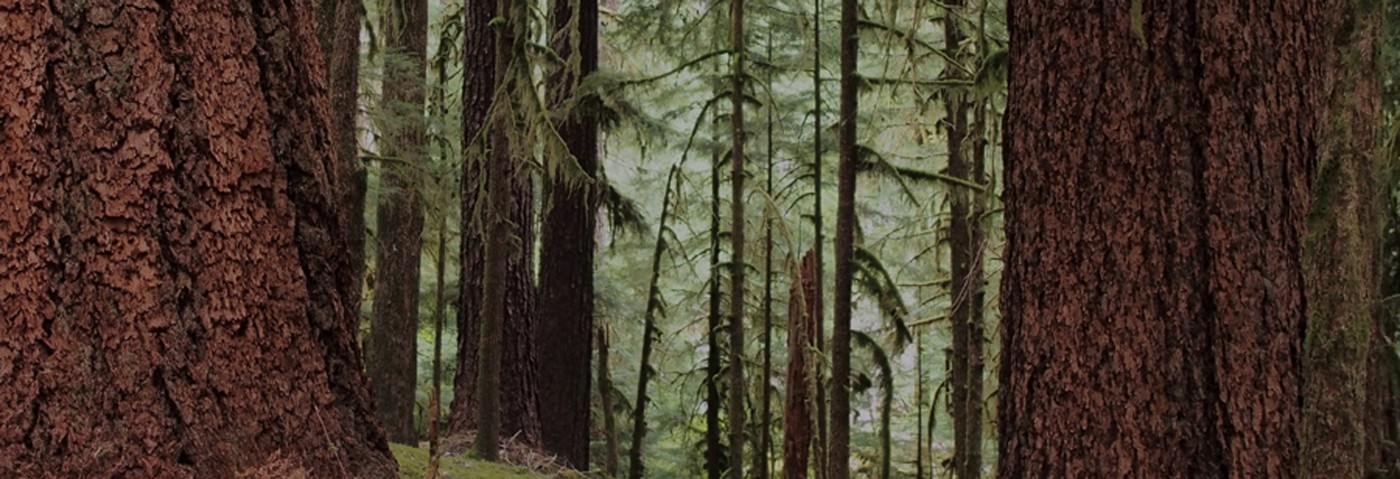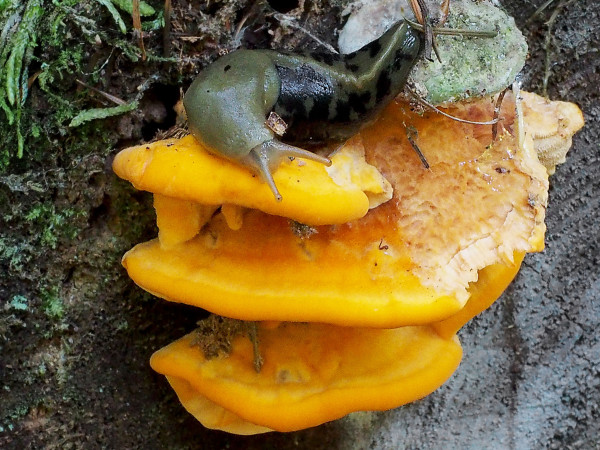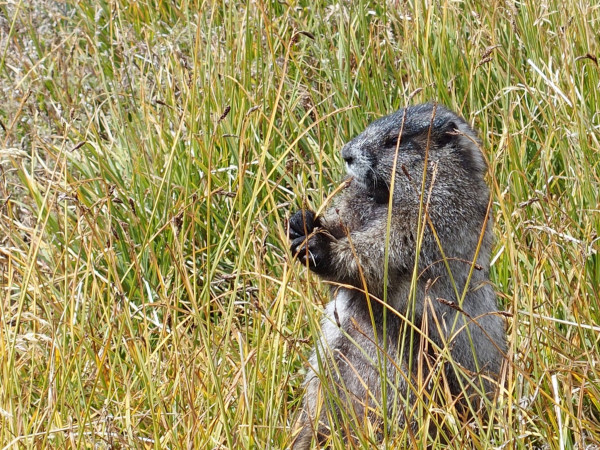Layers of Life
By John Palka — Posted March 6, 2016
Living things are almost never found in isolation. Rather, life occurs in communities and ecosystems. By no means all the members of a biological community are apparent to the naked eye or to the camera lens, but I find it rewarding to look for moments when the way a community functions reveals itself in a visible way. Here is one such moment.
I was walking along the upper trail in South Whidbey State Park one day when I came across this wonderful sight: a banana slug eating a fine specimen of chicken-of-the-woods growing luxuriantly on a fallen Douglas fir. The slug was quite active, and by the time I set up my tripod, I was able to get only half a dozen pictures before it curled up and became visually uninspiring. This is the best shot, and it shows a lot of biology.
First the actors. The banana slug (Ariolimax columbianus) is one of the iconic animals of the West Coast. This species occurs from Alaska to California and is the only common banana slug in Washington. At least two other species of Ariolimax occur further south.
The chicken-of-the-woods (usually identified as Laetiporus sulphureus) is a particularly spectacular tree-growing fungus with a very wide distribution. It is found not only across North America but in Europe as well. When a species seems to have such a wide distribution, biologists often wonder whether there are not actually multiple species that we do not yet know how to distinguish. Recent DNA and experimental evidence suggests that is the case for Laetiporus. Probably a more correct name for the chicken-of-the-woods that grows on western conifers is Laetiporus conifericola.
Our specimen is growing on the trunk of a fallen Douglas fir (Pseudotsuga menzesii). Douglas firs are one of the dominant tree species of the Northwest, and we have encountered them several times before in Nature’s Depths.
Having met the three species in this intimate scene, how can we penetrate beneath what we can see? I offer you three approaches.
1) Diversity. Let us begin by recognizing the diversity of life that the scene represents. The banana slug is an animal, the chicken-of-the-woods is a fungus, and the Doug fir is a plant. Biologists often divide all of life on Earth into six kingdoms: bacteria, the more recently recognized archaea, protists, fungi, plants, and animals. To a biologist, animals include a vast array of organisms beyond mammals, including fishes, insects, sea stars and many, many more. Archaea look like bacteria, but their biochemistry is so different that they have been separated out into their own kingdom. Both bacteria and archaea occur in vast numbers and diversity in essentially all natural environments. Protists are a very heterogeneous group into which this classification scheme places organisms that do not fit into any of the other five kingdoms.
In this single snapshot view, then, three of Earth’s six kingdoms of life are visibly represented. We can be sure that bacteria and archaea are also present, but neither they nor the protists are detectable without special techniques. Thus, we have at least five out of the six kingdoms of life living in the few cubic inches of the forest shown in the picture.
2) Details of life style. Every organism is functionally matched to the circumstances in which it lives, to the ecological niche that it inhabits. It is rewarding to contemplate the associated specializations and to think about the role these play in matching the organism to its environment.
We can explore this approach with all three of the organisms that star in our photograph—the tree, the fungus, and the slug. When looking carefully at the slug, for example, we notice that it has tentacles on the front of its head, and that the two conspicuous, long tentacles are tipped with little black dots. These are eyes. What can a banana slug see, we could wonder? Do its eyes help it navigate around its world? How would we find out?
Next to the slug we can see a whole array of small pits in the surface of the fungus. These illustrate how the slug eats. It has a raspy tongue called a radula with which it scrapes the surface of its food and sweeps the tiny fragments into its mouth. Sometimes the scrapings come from a surface layer of microorganisms. However, mushrooms of various kinds are favorite foods of snails and slugs, and in this case our Ariolimax is literally digging in. (How would you find out what a slug’s favorite foods are?)
The fungus itself, the chicken-of-the-woods, is also in the process of obtaining food, but this process is invisible to us. What we see as the fungus is only its reproductive structure, the fruiting body. The portion that assimilates nutrients from the environment is within the tree. It consists of very fine cellular threads, the hyphae, that ramify through the wood for long distances while secreting digestive enzymes into their immediate environment. These enzymes take apart the molecules out of which the tree had previously constructed its own tissues. The breakdown products are taken into the hyphae and are the sources of the metabolic energy that sustains the life of the fungus, as well as the building blocks out of which new fungal tissue is made. Individual hyphae are very thin and transparent, and are best seen with a microscope. Collectively, all of the hyphae that a single fungal organism makes are called its mycelium. We will have a much closer look at fungi in future posts.
3) Trophic levels. Biologists often think about ecological communities in terms of trophic levels (trophic means related to feeding or nutrition). Basically, this is a way of recognizing that the energy needed for life passes from one kind of organism to another, sometimes through feeding, sometimes in other ways. Think about energy flow in this forest scene.
- The Douglas fir captured energy from the Sun through photosynthesis. It used this energy, together with carbon dioxide from the air and water and nutrients brought up from the soil, to synthesize the molecules that make the cells that comprise its entire structure, the trunk included. The Doug fir is the first trophic level we see in our picture. It is called a primary producer because it produces living tissue out of non-living precursors with the aid of an external energy source, the Sun.
- The fungus obtains the energy it needs to build its own body from the decomposition of the trunk’s wood. Later we will look more carefully at how it does this. For now, just remember that the Sun’s energy sustains the life of the fungus via the molecules of the cells of the Douglas fir. Laetiporus is the second trophic level, and is regarded as a primary decomposer because it gets its nutrition directly from a primary producer and decomposes rather than swallows it.
- The banana slug is eating the fungus by rasping away its flesh, swallowing it, and digesting it. Ariolimax is the third trophic level. It is called a secondary consumer. Any animal that ate the slug would be a tertiary consumer. Ecosystems typically have only a handful of trophic levels, capped by the top predators.
In sum: the Doug fir in our photograph captured the energy of sunlight and stored it in the molecules that made up its body; the fungus digested and assimilated some of these molecules to obtain the energy stored in them, as well as to use them as raw materials for making its own cells; and the slug obtained the Sun’s energy by eating the fungus so that it could build its own body, and also behave.
In this example, the primary producer transferred the energy contained in its body to a primary decomposer. But the sequence is often different, as in this scene on Mt. Rainier.
It is late summer, and the hoary marmots (Marmota caligata) that live on the alpine meadows are already getting ready for winter. Like the ground squirrels, they store up fat for a long period of hibernation. Eating a variety of meadow flowers and grasses (photosynthetic primary producers, just like a Doug fir), these marmots belong to the second trophic level, the primary consumers. Among their predators are coyotes, eagles, and foxes, and they form the third trophic layer, the secondary consumers.
Notice that in our first scene, the second trophic level was represented by a decomposer, the chicken-in-the-woods, whereas in the second scene it was represented by an herbivore, the hoary marmot. Both the primary decomposer and the primary consumer obtained their energy and nutrition from photosynthetic primary producers. The concept of trophic levels focuses our attention on the flow of energy through biological systems.
We’ve also seen how every organism exhibits traits that suit it to its ecological niche, which is another way of saying that the magnificent diversity of form and function that we see in the living world has a biological purpose—to maximize an organism’s chances of growth and especially reproduction.
When you are outdoors, whether in the forest, or in a park, or in your own garden, bring to your conscious awareness the various kinds of organisms you see. Then think of them not so much as individuals but as members of a wider community in which diverse functional relationships occur. Try to imagine how you would study interactions you suspect are there but don’t really know about.
1,549 words




It is a treat to see your images and read about how you perceive them. When I saw the eyes of the slug , I felt closer to it. You see nature through a microscope and give it a unique perspective.
And then being a perverse seeker of humor, I got a giggle from discovering a creature named “hoary marmot”.No need to elaborate , I’m sure.
Thanks for sharing.
Hi Johnny – this was a treat to read, and will expand my walks in the woods – though maybe into more questions than answers! And that is the way to learn….. Thank you for these clear explorations..
Yes, questions are good!
Banana Slug eyes where I thought they were just antennae! It’s hard to imagine the anatomy of an eye that small! I can’t wait to walk in the woods and look more closely at one of these characters! Your camera lens captured such great detail! I love learning more about nature that goes beyond what OUR eyes usually see. Thank you, Johnny!
I have often been surprised myself at what I found in my photographs that I did not recognize when I took them. I think it’s partly the optics, but also the time that is available for careful scrutiny and appreciation when you have a photograph in front of you.